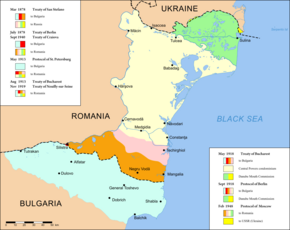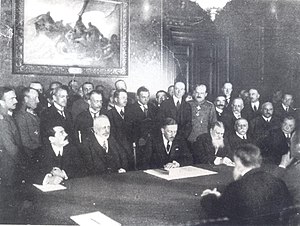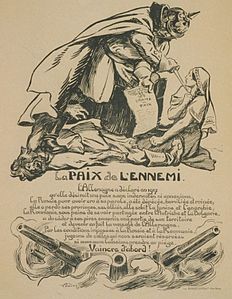Treaty of Bucharest (1918)
 Romanian prime minister Alexandru Marghiloman signing the treaty | |
| Signed | 7 May 1918 |
|---|---|
| Location | Cotroceni Palace, Bucharest, Kingdom of Romania[a] |
| Condition | Ratification by Romania and the Central Powers |
| Signatories |
|
| Parties | |
| Languages | German, Romanian, Hungarian, Bulgarian, Ottoman Turkish[3] |
The Treaty of Bucharest (1918) was a peace treaty between Romania and the opposing Central Powers following the stalemate reached after the campaign of 1917. This left Romania isolated after Russia's unilateral exit from World War I (see the Armistice of Focșani and Treaty of Brest-Litovsk).
Following the Central Powers' ultimatum issued during the meeting between Ferdinand I of Romania and Ottokar Czernin, the Austro-Hungarian Foreign Minister, on 27 February [O.S. 14 February] 1918 at the Răcăciuni railway station, King Ferdinand summoned a Crown Council on 2 March [O.S. 17 February] in Iași, the Romanian capital-in-exile. After long and difficult discussions, which lasted 3 days, and despite the strong opposition of Queen Marie and General Constantin Prezan, the Crown Council decided to accept the ultimatum and send envoys to Buftea to negotiate a preliminary peace treaty. The preliminary peace treaty was concluded on 5 March [O.S. 20 February] 1918, by which Romania accepted frontier rectifications in favor of Austria-Hungary, to cede the whole of Dobruja, to demobilize at least 8 divisions, to evacuate the Austro-Hungarian territory still in its possession and to allow the transport of Central Powers' troops through Western Moldavia and Bessarabia towards Odessa.[4]
Alexandru Marghiloman, then Prime Minister of Romania, signed the final treaty at the Cotroceni Palace, Bucharest, on 7 May [O.S. 25 April] 1918 and it was ratified by the Chamber of Deputies on 28 June and by the Senate on 4 July 1918.[5] However, King Ferdinand refused to sign or promulgate it.
Terms
[edit]- Romania and the Central Powers declared the end of the state of war between them[6][1] and that the diplomatic and consular relations between them would be resumed.[7][1]
- Demobilization of the Romanian forces
- Of Romania's 15 infantry divisions, divisions 11th to 15th were to be disbanded. Of the remaining 10 divisions, the two in Bessarabia were allowed to remain on a war footing, together with the Vânători battalions left over from the disbanded Vânători divisions, as well as the two Romanian cavalry divisions, until the military operations carried out by the Central Powers in Ukraine would eliminate the danger at the Romanian eastern frontier. The remaining eight divisions would remain on a reduced peace footing: four infantry regiments of three battalions each, two cavalry regiments of two squadrons each, two field artillery regiments of seven batteries each, one battalion of pioneers and the necessary technical troops and convoys. The total force of these eight infantry divisions could not exceed 20,000 men, that of the cavalry 3,200 men and that of the artillery 9,000 men. The divisions in Bessarabia were also to be decreased, in case of demobilization, to the peace footing on the basis of the eight divisions mentioned above.[8][1]
- The ordnance, machine guns, hand arms, horses, wagons and munitions made available during the reduction or disbanding of the Romanian troops were to be transferred to the high command of the Central Powers' forces and to be guarded by Romanian depot troops. Ammunition left with the Romanian divisions on peace footing was limited to 250 cartridges per musket, 2500 cartridges per machine gun, and 150 shots for each piece of ordnance. The divisions mobilized in Bessarabia were allowed to retain their ammunition needed for the state of war.[9][1]
- The demobilized troops were to remain in Moldavia until the evacuation of the occupied Romanian territory by the Central Powers, with the exception of the depot troops mentioned at article V. The troops in active service had to secure the permission of the Central Powers' high command if they wanted to pass into the occupied territory.[10][1]
- Romania and the Central Powers would appoint an officer from their respective General Staff as liaison officer to the other party.[11][1]
- The Romanian fluvial and maritime forces were allowed to remain intact until the conditions in Bessarabia were cleared up, afterwards they were to be reduced to a peace footing status, except for the fluvial and naval forces needed to protect the commercial navigation and the reestablishment of navigable lanes.[12] The military and naval personnel who in peace time was employed in the ports and in navigation was to be demobilized first, so that they could resume their former activity.[13][1]
- Cession of Romanian territory
- Romania returned Southern Dobruja (the Cadrilater) and ceded the southern part of Northern Dobruja (see the maps) to Bulgaria. The rest of the province (starting south of Cernavodă-Constanța railroad up to the Danube and the Sfântu Gheorghe branch, thus leaving the Danube Delta to Romania) was ceded by Romania to the Central Powers and thus remained under joint Central Powers' control. The Central Powers guaranteed the commercial road to the Black Sea for Romania by way of Cernavodă and Constanța.[14][1]
- Romania gave to Austria-Hungary control of the passes of the Carpathian Mountains (see the maps).[15][1]
- State properties in the territories ceded by Romania passed without indemnity to the acquiring states. The acquiring states were to enter with Romania into agreements over the rights of option and emigration for the Romanian inhabitants in the ceded territories, the apportionment of the properties of the communal districts severed by the new frontiers, the attribution of archives, of judicial, administrative and personal civil records, the management of the new frontiers, the effect of the new frontiers upon the dioceses and the political treaties.[16][1]
- All parties renounce war indemnities, except for special agreements regarding the regulation of war damages.[17][1]
- Romania leased its oil wells to Germany for 90 years.[18]
- The Central Powers recognized the Union of Bessarabia with Romania.[19]
- The German and Austrian occupation of Romania was to continue until a date "later to be determined".[20]
- All of the occupation costs were to be paid for by Romania.
- All of Romania's "surplus" agriculture was to be handed over to Austria-Hungary and Germany with an Austro-German commission deciding what was Romania's "surplus" production and what price to be paid for the "surplus" production.[20]
- All of the railroads, telephones, telegram and post systems in Romania were to remain under the control of Germany and Austria-Hungary.[20]
- German civil servants with the power to veto decisions by Romanian cabinet ministers and to fire Romanian civil servants were appointed to oversee every Romanian ministry, in effect stripping Romania of its independence.[20]
Aftermath
[edit]The treaty put Romania in a unique situation compared to other German-occupied countries. It completely respected Romania's de jure independence, and Romania ended up with more territory after the union with Bessarabia, through the requirement that German civil servants with the power of veto power be stationed in Bucharest together with the German occupation to continue until a date "later be determined", effectively turned Romania into a de facto German protectorate.[20]
Germany was able to repair the oil fields around Ploiești and by the end of the war had pumped a million tons of oil. They also requisitioned two million tons of grain from Romanian farmers. These materials were vital in keeping Germany in the war to the end of 1918.[21]
Although Bulgaria received a part of Northern Dobruja, the fact that it could not annex the whole province had a strong effect on the Bulgarian public opinion.[22] Bulgarian Prime Minister Vasil Radoslavov was forced to resign on 20 June 1918 after the failure to acquire the whole Dobruja.[22] Nevertheless, Bulgaria continued to lobby Germany and Austria-Hungary for the annexation of the whole province, including the condominium established by the Treaty of Bucharest. Representatives of Bulgarian Dobrujans held a second general assembly in Babadag on 23 September, adopting a final resolution requesting Dobruja's incorporation into Bulgaria.[22] After negotiations, a protocol regarding the transfer of the jointly administered zone in Northern Dobruja to Bulgaria was signed in Berlin on 24 September 1918, by Germany, Austria-Hungary, the Ottoman Empire and Bulgaria. In return, Bulgaria agreed to cede the left bank of the Maritsa river to Turkey.[22] The protocol was deemed a desperate attempt by the Central Powers to keep Bulgaria on their side[22] during the Vardar Offensive on the Macedonian front. In the end, the agreement was short-lived: five days later, on 29 September, Bulgaria capitulated in the face of the advancing Allied forces (see also the Armistice of Salonica).
The treaty was denounced in October 1918 by the Marghiloman government. Romania re-entered the war on 10 November 1918, the day before it ended in Western Europe, and the 1918 Treaty of Bucharest was nullified by the Armistice of 11 November 1918.[23] In 1919, Germany was forced in the Treaty of Versailles to renounce all the benefits provided by the 1918 Treaty of Bucharest.[24] The territorial transfers to Austria-Hungary and Bulgaria were annulled by the Treaty of Saint-Germain-en-Laye (1919), and the Treaty of Neuilly-sur-Seine (1919), respectively; and the Treaty of Trianon (1920) settled Romania's border with Hungary.
Maps
[edit]-
Map of Dobruja (areas in light blue, orange and pink were annexed by Bulgaria, while the area in yellow was to be administered jointly by the Central Powers)
-
Romanian territories ceded to Austria-Hungary (purple), Bulgaria (blue), and the Central Powers (green) through the Treaty of Bucharest. These changes were reversed by the Treaty of Versailles.
-
The Bulgaria–Romania border in Dobruja according to the Treaty (source: US Department of State, 1918)[1]
-
The situation on the Eastern Front in March 1918 (after the completion of the Operation Faustschlag)
-
The Carpatho-Danubian-Pontic Space on 7 May 1918 AD, after the Treaty of Bucharest. The Treaty, while signed by Prime Minister Alexandru Marghiloman, was never ratified by King Ferdinand I.
Image gallery
[edit]-
Foreign Minister of Austria-Hungary, Stephan Burián von Rajecz, signing the treaty
-
Picture taken at the signing of the treaty (Bulgarian State Archives). Bulgarian Prime Minister Vasil Radoslavov is fourth from the left, sitting.
-
Delegates at the signing of the treaty
-
French caricature on the Romanian-German peace: Kaiser Wilhelm II pointing a dagger at a woman (Romania), while showing her the terms of the treaty and stepping on the throat of a man (Russia)
See also
[edit]- Romania during World War I
- Treaty of Bucharest (1812)
- Treaty of Bucharest (1913)
- Treaty of Bucharest (1916)
Notes
[edit]- ^ Under Central Powers' occupation since December 1916)
References
[edit]- ^ a b c d e f g h i j k l m United States Department of State (1918). Texts of the Roumanian "Peace". Washington Government Printing Office.
- ^ "Preamble of the Treaty". Archived from the original on 24 March 2019. Retrieved 15 October 2019.
- ^ "Article XXX of the Treaty". Archived from the original on 24 March 2019. Retrieved 10 August 2017.
- ^ Nicolae Iorga, Acte privitoare la istoria marelui războiu, „Revista Istorică", Year XVIII, Issues 7-9, Bucharest, 1932
- ^ "Primary Documents - Treaty of Bucharest, 7 May 1918". FirstWorldWar.com. Retrieved 18 October 2019.
- ^ "Article I of the Treaty". Archived from the original on 24 March 2019. Retrieved 18 October 2019.
- ^ "Article II of the Treaty". Archived from the original on 24 March 2019. Retrieved 18 October 2019.
- ^ "Article IV of the Treaty". Archived from the original on 24 March 2019. Retrieved 18 October 2019.
- ^ "Article V of the Treaty". Archived from the original on 24 March 2019. Retrieved 18 October 2019.
- ^ "Article VI of the Treaty". Archived from the original on 24 March 2019. Retrieved 18 October 2019.
- ^ "Article VII of the Treaty". Archived from the original on 24 March 2019. Retrieved 18 October 2019.
- ^ "Article VIII of the Treaty". Archived from the original on 24 March 2019. Retrieved 18 October 2019.
- ^ "Article IX of the Treaty". Archived from the original on 24 March 2019. Retrieved 18 October 2019.
- ^ "Article X of the Treaty". Archived from the original on 24 March 2019. Retrieved 17 September 2017.
- ^ "Article XI of the Treaty". Archived from the original on 24 March 2019. Retrieved 18 October 2019.
- ^ "Article XII of the Treaty". Archived from the original on 24 March 2019. Retrieved 18 October 2019.
- ^ "Article XIII of the Treaty". Archived from the original on 24 March 2019. Retrieved 18 October 2019.
- ^ Tarján, M. Tamás. "1918. május 7. - Románia és a központi hatalmak aláírják a bukaresti békét". www.rubicon.hu. Rubiconline.
- ^ R. J. Crampton, Eastern Europe in the twentieth century, Routledge, 1994, ISBN 978-0-415-05346-4, p. 24–25
- ^ a b c d e Kitchen, Martin "Hindenburg, Ludendorff and Rumania" pages 214-222 from The Slavonic and East European Review, Volume 54, Issue # 2, April 1976 page 223.
- ^ John Keegan, World War I, pg. 308
- ^ a b c d e Roumen Dontchev Daskalov; Diana Mishkova; Tchavdar Marinov; Alexander Vezenkov (30 January 2017). Entangled Histories of the Balkans. Vol. 4. BRILL. p. 358. ISBN 978-90-04-25075-8.
- ^ Armistice convention of 11 November 1918 (PDF), 11 November 1918, archived from the original (PDF) on 23 November 2018, retrieved 17 November 2017, Article XV.
- ^ Articles 248–263 - World War I Document Archive
External links
[edit]- World War I treaties
- Treaties concluded in 1918
- 1918 in Romania
- Bucharest in World War I
- Romania in World War I
- Territorial evolution of Romania
- Austria-Hungary in World War I
- Peace treaties of Austria
- Peace treaties of Germany
- Peace treaties of Romania
- Peace treaties of Bulgaria
- Peace treaties of the Ottoman Empire
- Treaties involving territorial changes
- Treaties of the German Empire
- Treaties of Austria-Hungary
- Treaties of the Kingdom of Romania
- Treaties of the Kingdom of Bulgaria
- Bulgaria in World War I
- Germany–Romania relations
- May 1918



![The Bulgaria–Romania border in Dobruja according to the Treaty (source: US Department of State, 1918)[1]](http://upload.wikimedia.org/wikipedia/commons/thumb/d/dd/Territory_taken_from_Roumania_by_Bulgaria_according_to_the_Peace_of_Bucharest_%281918%29.png/290px-Territory_taken_from_Roumania_by_Bulgaria_according_to_the_Peace_of_Bucharest_%281918%29.png)







